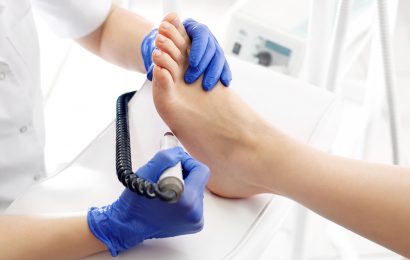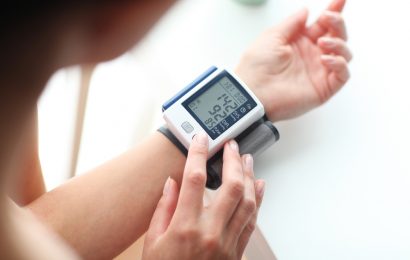No one wants to get a foot ulcer, but unfortunately, according to the American College of Foot and Ankle Surgeons, people with diabetes have a 15% chance of developing one at some point in their lives. Ulcers and other wounds are often the by-product of sensory neuropathy, a complication of diabetes that causes people to lose sensation on the bottoms of their feet. Without this protective sensation, the feet are vulnerable to repeated pressure or trauma that can cause injury. Peripheral vascular disease, in which blood vessels that serve outlying parts of the body narrow, is another potential complication of diabetes that can contribute to foot ulceration. By reducing the flow of blood to the feet, peripheral vascular disease decreases their supply of oxygen and nutrients, making it harder for wounds on the feet to heal.
Foot ulcers that are left untreated or are treated improperly can develop debilitating infections and put people at risk for lower-limb amputations. If you develop a foot ulcer, getting prompt and aggressive treatment is the best way to help the ulcer heal and avoid further complications. For this reason, a specialized wound care center may be a good option for treatment. Multiple scientific studies have shown that people with diabetic foot ulcers achieve better outcomes when treated by a multidisciplinary team of health-care providers. A wound care center not only concentrates a variety of specialists in one place, but it can also provide a range of advanced wound care therapies, one or more of which may be the right choice for treating your wound.
Since the mid-1980’s, wound care centers have been developing throughout the United States. Initially, each of these programs focused on a specific type of therapy and did not truly provide comprehensive care. Over time, however, and with the growing number of wound care products and technologies now available, multidisciplinary wound care centers have become common on the health-care landscape. Most wound care centers achieve a high success rate through collaborative work among various team members. Centers also develop expertise simply by seeing a large volume of patients with similar problems. Overall healing rates of around 80% should be achievable within 16 weeks of therapy at a specialized wound care center.
If you are referred to a wound care center for treatment of a foot ulcer or other condition, it would serve you well to educate yourself about the staff, treatments, and educational options available at the center. This article explains how wound care centers work and some of the innovative treatments they can provide for diabetic foot ulcers.
What to expect at a wound care center
Most wound care centers are located within or immediately adjacent to an acute care hospital. The center may be run by the hospital, or the hospital may choose to subcontract with a management company that runs wound care centers across the country. A panel of physicians works at the center, with each physician traditionally covering a half-day clinic. The physicians’ primary areas of training can be varied. Primary care, surgery, orthopedic, podiatric, and internal medicine physicians are but a few of the possible specialists found in a wound care center. All of them, however, should have additional training specific to wound care. This training may come from attending seminars and workshops or, in the case of corporate-run wound care centers, participating in formal wound care education programs. There is also currently a process by which health-care providers can take an examination sponsored by the American Academy of Wound Management. Successful completion of the examination results in the clinician obtaining the C.W.S. (Certified Wound Specialist) designation. There is, however, no formal board certifying process at this time for physicians in the field.
The multidisciplinary team at a wound care center may consist of a variety of additional health-care professionals. Most wound care centers have wound nurses on staff, many of whom have credentials such as CWCN (Certified Wound Care Nurse), CWON (Certified Wound Ostomy Nurse), or CWOCN (Certified Wound, Ostomy, and Continence Nurse). These credentials are available to nurses who either complete specific coursework or accrue a certain number of hours of experience in the field of wound care.
Other members of the wound care team may include orthotists, who design and fit braces, splints, and special foot-wear; physical therapists, who can help a person return to his regular activities as the wound is treated; medical technicians, who specialize in certain diagnostic techniques or therapies (such as a Certified Hyperbaric Technologist, or CHT); diabetes educators; dietitians; and physicians from various other specialties.
Treatment at a wound care center usually begins with a comprehensive medical history and physical exam. The wound care center clinician who examines you needs to know about any past surgical procedures you have undergone, medicines you take, and medical conditions you have to arrive at an accurate diagnosis of your wound. Plan to bring this information with you on your first visit. During this visit the clinician may also perform a vascular test. This test may be as basic as feeling for pulses or may involve a Doppler examination, in which sound waves are used to generate audible signals that correlate with the blood flow through your veins and arteries. Both of your feet should be evaluated during the first visit and possibly also at subsequent visits. If the clinician who examines you does not ask to see both feet, ask that he do so. The clinician should also perform some form of sensory testing to the bottoms of your feet to check for sensory neuropathy. The inability to feel pressure from a 10-gram sensory testing nylon monofilament at any one site is equivalent to having loss of protective sensation. This finding indicates a high risk for developing a foot ulcer and may require the use of special therapeutic shoe inserts to lessen this risk. People with loss of protective sensation should be fitted with inserts for their shoes, and if their neuropathy is severe and/or significant foot deformities are present, custom-molded shoes will be required as well. Often, a person with diabetes first becomes aware of his sensory neuropathy during one of these exams.
After your initial exam, it is very common for lab testing and x-rays to be ordered. Once the wound care team has all of the relevant background information, they will be able to select a specific dressing for your wound, and you and/or your caretaker will be instructed on proper dressing techniques for home use. For most purposes, moist wound-healing treatments are used. This means that the wound is maintained in a moist environment at all times. (The traditional belief that “letting the air get to it” is the best technique for treating a wound has long been disproved; this technique actually often leads to overdrying of the wound bed, with subsequent poor healing.)
In addition to wound care therapy, a wound care clinic should provide educational resources and hands-on education. Information sheets on proper foot care, nutrition, wound treatments, and warning signs to watch for should all be available. Organizations such as the American Diabetes Association, the Wound Healing Society, and the American College of Foot and Ankle Surgeons supply printed guidelines for diabetic foot care. Inquire about these documents when you visit the wound care clinic.
After two to four weeks of appropriate wound care, you and your wound care clinicians should notice a significant improvement in the wound bed. Improvement may be evidenced by a decrease in wound size or an improvement in the quality of the wound bed tissue. For example, the elimination of yellow debris and the appearance of granulation tissue, which is red due to the presence of newly formed blood vessels, is a positive sign of healing. During this time the clinicians should also evaluate your overall blood glucose control because it is known that people with high blood glucose levels also demonstrate delayed wound healing. It is at this point in the process that a dietitian or diabetes educator may meet with you to help you develop strategies to better control your diabetes. The diabetes educator plays a vital role in a comprehensive wound care program.
Advanced therapies
If, after the first four weeks of treatment, there is no significant improvement in a person’s wound, the wound care clinician may recommend an advanced wound healing therapy. Over the past 10 years, there has been an explosion of new wound-healing technologies introduced into the marketplace. Some of the more common treatments are the following:
Surgical debridement. It has been shown that diabetic foot ulcers heal faster when surgical, or sharp, debridement is performed on an initial and routine basis. In this procedure, the clinician uses an array of sharp instruments such as scalpels, curettes, or scissors to remove debris from the wound bed. Most people with diabetes, because of their sensory neuropathy, do not have any discomfort with this procedure. Advanced wound care dressings that provide a moist environment are used in conjunction with surgical debridements.
Enzymatic debriding agents. Enzymatic debriding agents can be thought of as “scalpel blades in a tube.” These enzyme-containing ointments chemically disrupt or digest nonviable tissue in the wound and promote healing. Usually applied once a day at home, these ointments can be very effective in the removal of dead or diseased tissue, but the process is much slower than surgical debridement. Sometimes the two treatments are used in conjunction with one another.
Energy therapies. Sometimes a wound can “stagnate” or become “stunned,” and at this point a wound care technique that imparts energy into the wound bed may be useful to kick-start the healing process. Therapies such as electrical stimulation (in which a high-voltage, pulsed current is applied to the wound), ultrasound (in which high-energy sound waves penetrate tissues to speed healing), and most recently, the MIST Therapy System (which uses an ultrasound-created mist to promote wound healing) have been used with success to treat people with stubborn diabetic foot ulcers. The use of these therapies requires the person being treated to come to the wound care center at least three times a week in addition to his regular appointments. These treatments are usually used for two to four weeks or until the ulcer begins healing again.
Pulse lavage therapy. Historically, whirlpool was a very popular technique for treating diabetic foot ulcers. Recently, however, this technique has been replaced with pulse lavage therapy. Pulse lavage is performed with a water-gun—like device coupled with a suction device to clean and debride the wound at the same time. Pulse lavage is usually only used for a few treatments at the beginning of the wound treatment process.
Bioengineered tissue treatment. Over the past several years, bioengineered tissues have become available for use in people with diabetic foot ulcers. These tissues can be made from living human cells or can be composed of a collagen lattice that acts as scaffolding within which the body’s own cells can migrate and begin the healing process. Some of these products are applied once and followed with secondary dressing changes over four weeks, while others require weekly applications. Most, if not all, of the work can be done in an outpatient setting.
Oxygen therapies. Hyperbaric oxygen therapy, a therapeutic option for selected people with diabetic foot ulcers, requires the person being treated to lie inside an acrylic tube that is filled with 100% oxygen under two to three times the normal atmospheric pressure. This therapy works by increasing the amount of oxygen in the blood and available to the body’s tissues. A person can usually watch TV, listen to music, or engage in conversation or relaxation techniques during the therapy sessions, which typically last 1.5—2 hours and take place daily for, on average, 20—30 treatments. It is important to know that inhaling oxygen under pressure is the only type of oxygen therapy approved by Medicare. Topical oxygen therapy (when the affected area of the body is placed in a tent filled with oxygen) has been shown to have some positive clinical effects, but is not yet covered by Medicare.
Vacuum-assisted closure therapy. Recent studies have demonstrated benefit in healing foot ulcers and wounds in people with diabetes with the use of negative-pressure therapy known as vacuum-assisted closure, or VAC, therapy. This technology consists of a polyurethane sponge that is placed on the wound bed and attached to a plastic tube, which is then attached to a pump that creates a negative suction force that helps drain the wound and influences the growth of surface tissue. The negative force can be applied continuously or intermittently. This therapy can be used 24 hours a day, but with the advent of newer, portable devices, it is possible to undergo outpatient therapy. The portable device attaches to a person’s belt and can be worn throughout the day without interrupting normal activities.
Growth factor treatment. Human growth factors are hormones that are normally involved in the healing process, and engineered versions of these hormones are now being used in the treatment of diabetic foot ulcers to stimulate healing. Since achieving FDA approval as the first engineered growth factor for topical wound use, a gel containing recombinant human platelet-derived growth factor (rhPDGF) has been used to treat diabetic foot ulcers. In clinical trials, rhPDGF has been shown to help heal diabetic foot ulcers and prevent amputation better than standard or placebo therapy. The gel is applied to the wound daily at home, and weekly visits are made to the wound care center to monitor progress.
Staying vigilant
After a person’s wound has healed, there is still more work to be done. People with a history of prior diabetic wounds are at high risk for developing subsequent ulcers and therefore a constant diligence is required to prevent recurrences. Special shoe inserts generally need to be changed every three to four months, though the life expectancy of the inserts depends on the material they are made from, the wearer’s weight, and how much walking the wearer does. Customized shoes should be evaluated by a professional at least annually. At all visits to your primary-care physician, you should remove your shoes and socks before the doctor comes into the exam room. This will prompt the doctor to evaluate your feet for deformities, new ulcers, and callus formation (which can lead to ulcers), and to monitor your sensory status.
Diabetic foot ulceration is a major health-care problem with both high monetary and quality-of-life costs. If you develop an ulcer, seeking treatment from a well-staffed, multidisciplinary wound care team can significantly improve your chances for a successful outcome. Another thing you can do to improve your outcome is to become an active participant in the process. Gather all of your pertinent medical records and lab tests and bring copies with you to your first clinic visit. Read up on recent updates and advances for diabetic foot care on the Internet or at the library. Don’t hesitate to ask questions, because the more you learn, the more you can participate in the wound care team. These measures, combined with the advent of new products and methods of treatment, should put you well on your way to healing.





